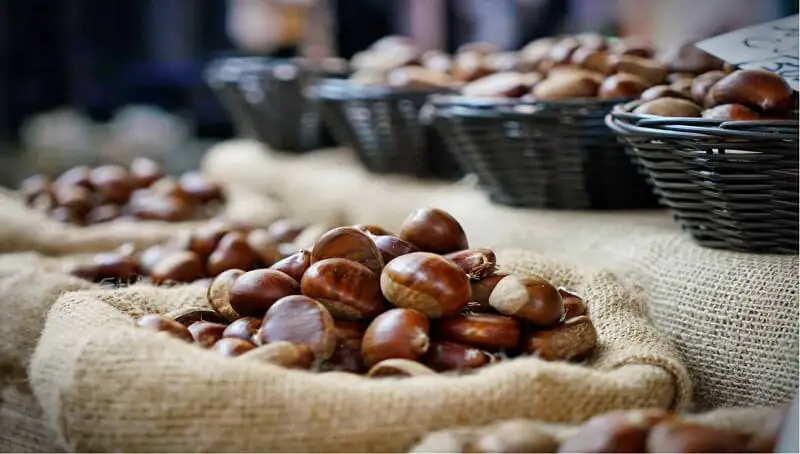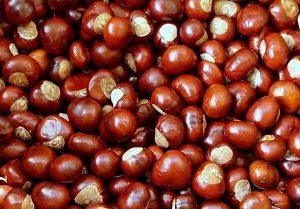
How Many Teeth Does A Ball Python Have?
April 26, 2022
Can Rabbits Eat Raspberries? Any Risks?
April 27, 2022
Although today the quality of food is very high, there are many owners who do not hesitate to give their dogs homemade meals, with the food they eat. This may be a good idea because there are many foods that are healthy for dogs, but since they don’t have the same body and digestive system as a human, sometimes we give them things that don’t make them feel good.
During autumn, more and more types of nuts are consumed, and among them are chestnuts, very typical of the season. Chestnuts have certain properties and can be eaten in many different ways, but you should know for sure whether dogs can eat chestnuts before adding them to their diets.
So can dogs eat chestnuts?
The answer is yes, dogs can eat chestnuts, but they should do so in moderation. Chestnuts are a food that is not very easy to digest and therefore in large quantities can cause stomach disorders, from gas to vomiting or diarrhea. This is because they are high in fiber, which is beneficial only in small amounts. These chestnuts should not be too green, as the greener ones are undigestible. In addition, you must always remove the peel, because otherwise, the dogs will eat it too.
Nutritional composition of chestnuts
As I have already said, chestnuts are rich in fiber, therefore, in small quantities, they improve the intestinal transit of the dog. Like many other nuts, they have omega 3 and 6, fatty acids, so they are beneficial for the skin and heart. It is a food that also has minerals and B vitamins, which are responsible for keeping the nervous system in good condition, preventing diseases related to it. They also have a lot of calcium, so they are ideal for maintaining the health of your dog’s teeth and bones.
You might also like my articles on whether dogs can eat figs, chili beans, or pistachio nuts.
In a quantity of 100 grams of chestnuts, we can find some interesting nutritional contributions. For example, they have 224 kcal, 4,20 grams of protein, and 18 mg of calcium. They also have phosphorus, magnesium, potassium, sodium, and zinc. They have vitamin C, B6, and vitamin A. In general, a dog should be fed with just a few chestnuts, depending on the size of the dog, because otherwise you can saturate it and cause problems to its stomach.
Although at a glance, the number of certain nutrients is high, you should keep in mind that we are talking about 100 grams of chestnuts, an amount far higher than what we should offer the animal in one serving.
Benefits of chestnuts in dogs
 Now that we know that dogs can eat chestnuts in a controlled and moderate way, what benefits do they bring? While it is true that it is not one of the most recommended nuts for dogs, it has an interesting nutritional composition, as we have already seen, which translates into multiple beneficial properties for their body system.
Now that we know that dogs can eat chestnuts in a controlled and moderate way, what benefits do they bring? While it is true that it is not one of the most recommended nuts for dogs, it has an interesting nutritional composition, as we have already seen, which translates into multiple beneficial properties for their body system.
- They promote bone and dental health
Due to the amount of calcium they come with, chestnuts are good for improving the condition of your dog’s teeth and bones. For this, it is essential to follow proper dental hygiene and perform proper physical exercise. Keep in mind that carrying out physical activities not recommended for the animal can damage the health of bones and joints, despite the consumption of calcium in their diet.
- It is suitable for dogs with diabetes
If they suffer from diabetes, you should know that they can still enjoy this delicious fruit from time to time as a reward or treat. This is due to the carbohydrates found in the composition of chestnuts.
- Improvement of intestinal transit
Properly offered, they favor the intestinal flora of the dog due to its amount of fiber. However, in excess they can have the opposite effect, causing intestinal problems instead of improving digestive transit. Therefore, offered in moderation is essential.
How to feed a dog chestnuts?
As we have shown in the previous sections, dogs can eat chestnuts from time to time and in small amounts, ideally, do not give it more than one at a time. It is also not advisable to give your dog this dry fruit every day, as an excess of its consumption can cause the following health problems:
- meteorism
- vomiting
- diarrhea
- discomfort
- stomach pain
On the other hand, if you’ve never given this food to your dog before, I recommend trying a piece of chestnut first and observing its reaction. If they do not develop allergy symptoms, you can continue to give them the fruit as a reward or treat. Also, if your dog tends to not chew the food, keep in mind that chestnuts have a pretty tough consistency and could stick in its throat and even cause suffocation if you don’t chop them before.
Can dogs eat roasted chestnuts?
Lightly toasted yes, as we would cook them for human consumption, but fried or in syrup NO. As already mentioned, it is best to offer them peeled and raw fruits, since added salt or fried chestnuts can harm the animal and promote the development of already mentioned intestinal problems. Of course, if your dog has eaten a fried chestnut or a piece of roasted chestnut, it should not show any negative symptoms.
I recommend that in case of severe poisoning due to accidental ingestion of bigger amounts, always go to your veterinarian and only talk to experts. My recommendation is that if you want to start giving your dog a healthy and natural diet, consult with professionals, who are specialized in dog nutrition.
